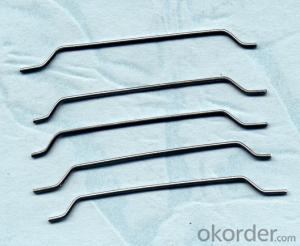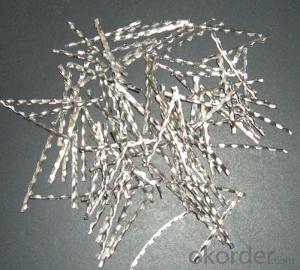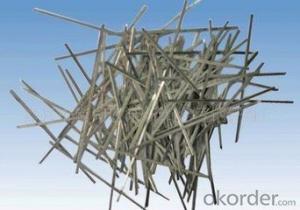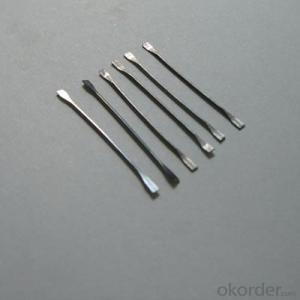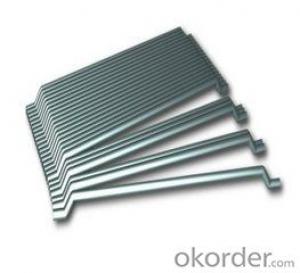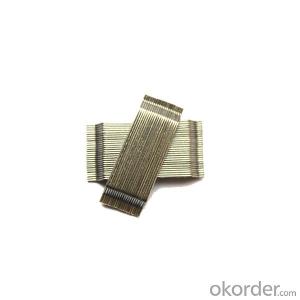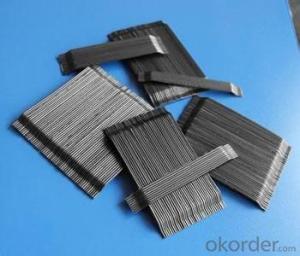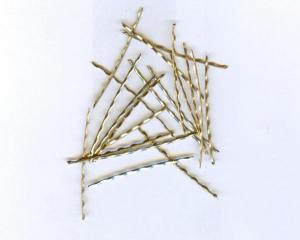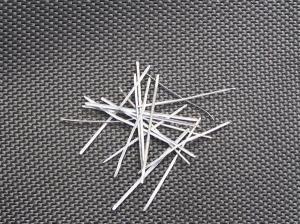Steel Fiber Straight Type China Company CNBM
- Loading Port:
- Tianjin
- Payment Terms:
- TT OR LC
- Min Order Qty:
- 1000 kg
- Supply Capability:
- 30000 kg/month
OKorder Service Pledge
OKorder Financial Service
You Might Also Like
Quick Details
Place of Origin: Jiangsu, China (Mainland)
Model Number: HT-ST
Material: Steel
Specifications
Specifications
Produces shear type, steel wire type, cut type, stainless type, and micro wire type steel fiber. It is used for concret.
SPECIFICATION
TYPE | SIZE | tensile strength |
ENDHOOKED STEEL FIBER | 0.5×0.5×30 mm | 850Mpa min |
0.6×0.7×35 mm | 850Mpa min | |
0.5×0.5×30 mm | 1000MPA min | |
0.6×35 mm | 1000MPA min | |
0.9×60 mm | 1000MPA min | |
CORRUGATED STEEL FIBER | 0.25×0.25×10 mm | 380Mpa min |
0.25×0.25×14 mm | 380Mpa min | |
0.5×0.7×32 mm | 380MPA min |
OTHER SPECIFICATIONS CAN BE DISCUSSED AS PER BUYER’S OPTION
Picture
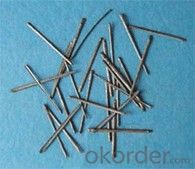
Steel fiber straight type

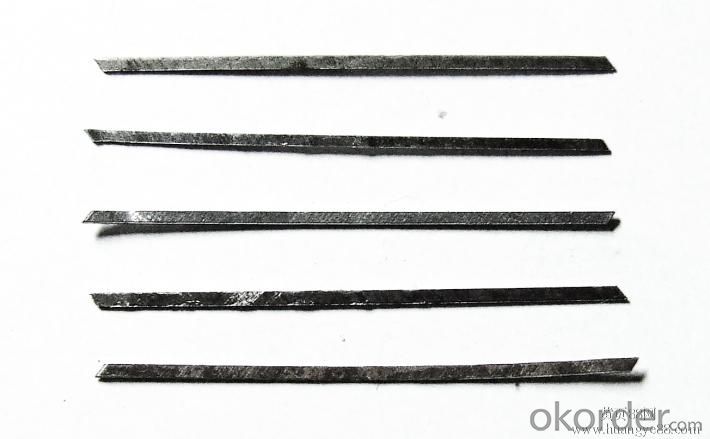
FAQ
certificated: ISO 9001
Technical advantages of Daye steel fiber:
A. Improve mechanical performance of concrete
B. Provide uniform distribution throughout concrete with excellent mixing
C. No balling or caking by adopt correct mixing method
D. Reduce concrete volume
E.Save construction time and cost
F.Reduce excavation volume
G.Available for jointless floor.
- Q:What is the effect of melt extract stainless steel fiber on the impact resistance of concrete?
- The effect of melt extract stainless steel fiber on the impact resistance of concrete is that it significantly improves the concrete's ability to withstand impact forces. The inclusion of stainless steel fibers in the concrete matrix enhances its resistance to cracking and spalling, thereby increasing its overall durability and strength. These fibers act as reinforcement, distributing the impact load more evenly throughout the concrete structure, reducing the likelihood of sudden failure or damage. This ultimately leads to improved impact resistance and a longer service life for the concrete.
- Q:Can melt extract stainless steel fiber be used in the construction of parking structures?
- Yes, melt extract stainless steel fiber can be used in the construction of parking structures. It provides reinforcement to concrete, enhancing its strength, durability, and resistance to cracking.
- Q:Is melt extract stainless steel fiber resistant to corrosion?
- Melt extract stainless steel fiber exhibits exceptional resistance to corrosion. It is produced from a top-quality steel alloy that incorporates chromium, forming a protective layer on the fiber's surface. This layer, called a passive layer, effectively shields the steel from direct contact with corrosive elements found in the surroundings, such as moisture, oxygen, and chlorides. Consequently, the fiber maintains its resistance to rust and corrosion even in extreme conditions, including high temperatures, acidic or alkaline environments, and exposure to chemicals. Hence, melt extract stainless steel fiber proves to be an outstanding option for various applications requiring corrosion resistance, such as concrete reinforcement, refractory materials, and composite materials.
- Q:Is melt extract stainless steel fiber suitable for use in architectural concrete?
- Yes, melt extract stainless steel fiber is suitable for use in architectural concrete. Stainless steel fibers offer enhanced durability, strength, and crack resistance to concrete structures. They can help improve the overall performance and longevity of architectural concrete by reducing shrinkage, increasing flexural strength, and improving resistance to impact and abrasion. Additionally, melt extract stainless steel fibers have excellent corrosion resistance properties, making them ideal for use in architectural concrete exposed to harsh environments or corrosive agents.
- Q:How does melt extract stainless steel fiber affect the workability of shotcrete?
- Shotcrete's workability can be significantly improved by incorporating melt extract stainless steel fiber. Shotcrete, a method of applying concrete or mortar through a high-pressure hose, is widely used in construction due to its versatility and ability to be molded into various shapes. However, shotcrete often faces challenges in terms of workability, such as flow control, shrinkage reduction, and overall strength enhancement. To address these limitations and improve workability, melt extract stainless steel fiber is added to the shotcrete mix as reinforcement. Produced through a melting and extraction process, these fibers offer several benefits that enhance shotcrete's workability. Firstly, the stainless steel fibers enhance control over shotcrete flow, making it easier to manipulate and shape during application. Acting as three-dimensional reinforcement, these fibers evenly distribute forces and minimize slump loss caused by excessive fluidity. This improved control allows for precise shaping and ensures proper adhesion to the desired surface without segregation. Secondly, the addition of stainless steel fibers helps reduce shrinkage and cracking in shotcrete. As shotcrete cures, shrinkage can occur due to the drying of cementitious materials. However, stainless steel fibers provide a reinforcement network that restrains shrinkage, preventing crack formation and enhancing shotcrete's overall durability. This is especially beneficial in areas where cracks and shrinkage can lead to structural issues or water infiltration. Lastly, melt extract stainless steel fibers enhance the strength and toughness of shotcrete. Acting as reinforcement, these fibers create a matrix that improves the mechanical properties of shotcrete. As a result, shotcrete becomes more resistant to impact, abrasion, and fatigue, making it more resilient and durable. In conclusion, incorporating melt extract stainless steel fibers has a positive impact on shotcrete's workability. By improving flow control, reducing shrinkage and cracking, and enhancing strength and toughness, these fibers contribute to the overall quality and performance of shotcrete applications in construction projects.
- Q:Is melt extract stainless steel fiber compatible with different types of cement?
- Melt extract stainless steel fiber is indeed compatible with various types of cement. It proves suitable for both Portland cement and other varieties like slag cement, fly ash cement, or blended cements. By incorporating these stainless steel fibers into the cement mixture, one can effectively bolster its performance and bolster its durability. These fibers actively manage cracking and offer reinforcement to the cement matrix, leading to heightened tensile strength, impact resistance, and fatigue resistance. As a result, melt extract stainless steel fiber emerges as an adaptable material that can elevate the qualities and performance of diverse cement types.
- Q:Can melt extract stainless steel fiber be used in high-performance concrete mixtures?
- Yes, melt extract stainless steel fiber can be used in high-performance concrete mixtures. This type of fiber enhances the mechanical properties of concrete, such as increasing its tensile strength, crack resistance, and durability. It is particularly suitable for applications that require high-performance concrete, such as structural elements in buildings, bridges, and road pavements, where improved strength and durability are important.
- Q:How is melt extract stainless steel fiber manufactured?
- Melt extract stainless steel fibers are manufactured through a specialized process involving the melting of stainless steel alloys and subsequent extraction of the molten metal into tiny fibers. The manufacturing process typically starts with the selection of high-quality stainless steel alloys, which contain a combination of iron, chromium, nickel, and other elements. Firstly, the selected stainless steel alloys are heated to extremely high temperatures until they reach their melting point. This is typically done in a furnace or an electric arc melting system. Once the alloys are completely molten, they are ready for the extraction process. The molten stainless steel is then forced through a series of fine spinnerets or nozzles at high velocities. These spinnerets have small openings, which allow the molten metal to pass through and form continuous fibers. The size of the spinneret openings determines the diameter of the resulting stainless steel fibers. As the molten stainless steel exits the spinnerets, it rapidly cools down, solidifying into solid fibers. These fibers are then collected and further processed to remove any impurities or contaminants. This can be done through mechanical means such as air jets, or by chemical methods like acid washing or pickling. Once the fibers are cleaned and purified, they are typically cut into shorter lengths based on the desired application. The final product can vary in length depending on the specific requirements of the end user, ranging from a few millimeters to several centimeters. Overall, the process of manufacturing melt extract stainless steel fibers involves the melting of stainless steel alloys, extraction through spinnerets, cooling and solidification, purification, and cutting into desired lengths. This manufacturing process ensures the production of high-quality stainless steel fibers that can be used in various applications such as reinforcement in concrete, thermal insulation, and electromagnetic shielding.
- Q:Can melt extract stainless steel fiber be used in lightweight concrete wall panels?
- Indeed, the implementation of melt extract stainless steel fiber is feasible for the construction of lightweight concrete wall panels. It is customary to incorporate stainless steel fibers into concrete mixtures to enhance the material's robustness, longevity, and resistance to cracking. By utilizing stainless steel fibers in lightweight concrete wall panels, one can augment their reinforcement without significantly augmenting their weight. Consequently, this facilitates the production of sturdier and more secure lightweight concrete wall panels capable of withstanding diverse external forces and environmental conditions. Furthermore, the corrosion-resistant nature of stainless steel fibers contributes to the durability and lifespan of the wall panels. Hence, melt extract stainless steel fiber proves to be a fitting option for reinforcing lightweight concrete wall panels.
- Q:Are there any guidelines or standards for using melt extract stainless steel fiber in construction?
- Yes, there are guidelines and standards for using melt extract stainless steel fiber in construction. These guidelines provide recommendations for the appropriate dosage, distribution, and mixing of the fiber in concrete or mortar, as well as guidance on the design and construction of fiber-reinforced concrete structures. Additionally, there are standards that specify the mechanical properties, dimensions, and testing requirements for melt extract stainless steel fibers used in construction applications. Following these guidelines and standards ensures the safe and effective use of melt extract stainless steel fiber in construction projects.
1. Manufacturer Overview |
|
|---|---|
| Location | |
| Year Established | |
| Annual Output Value | |
| Main Markets | |
| Company Certifications | |
2. Manufacturer Certificates |
|
|---|---|
| a) Certification Name | |
| Range | |
| Reference | |
| Validity Period | |
3. Manufacturer Capability |
|
|---|---|
| a)Trade Capacity | |
| Nearest Port | |
| Export Percentage | |
| No.of Employees in Trade Department | |
| Language Spoken: | |
| b)Factory Information | |
| Factory Size: | |
| No. of Production Lines | |
| Contract Manufacturing | |
| Product Price Range | |
Send your message to us
Steel Fiber Straight Type China Company CNBM
- Loading Port:
- Tianjin
- Payment Terms:
- TT OR LC
- Min Order Qty:
- 1000 kg
- Supply Capability:
- 30000 kg/month
OKorder Service Pledge
OKorder Financial Service
Similar products
New products
Hot products
Hot Searches
Related keywords
